Serviços Personalizados
Artigo
Links relacionados
Compartilhar
Odontologia Clínico-Científica (Online)
versão On-line ISSN 1677-3888
Odontol. Clín.-Cient. (Online) vol.14 no.4 Recife Out./Dez. 2015
Artigos Originais / Original Articles
CRITERIA USED BY DENTISTS OF RECIFE-BRAZIL FOR THE EVALUATION OF FACIAL AESTHETICS
Critérios utilizados pelos cirurgiões dentistas de Recife- Brasil para a avaliação da estética facial
Silvana Orestes-CardosoI; Kamilla Maurício PassosII; Maria Eugênia de Meira Lins CaracioloII; Milena Vieira da Silva MeloII; Antonio Jorge Orestes-CardosoIII; Raíssa Orestes-CarneiroIV
I PhD, Department of Prosthesis and Maxillofacial Surgery, Federal University of Pernambuco (UFPE), Recife-PE, Brazil
II Dentists, graduated at Dental School, Federal University of Pernambuco (UFPE), Recife-PE, Brazil
III MSc, Department of Oral and Maxillofacial Surgery, Hospital Getúlio Vargas, Recife-PE, Brazil
IV Mc, S Department of History, Federal University of Pernambuco (UFPE), Recife-PE, Brazil
ABSTRACT
Purpose: The present study proposes to investigate the criteria used by Dentists of Recife, Brazil, for the evaluation of facial aesthetics of their patients. Materials and Methods: Through a questionnaire elaborated and pre-tested by the researchers, 342 Dentists were randomly interviewed. For the data analysis, it was used the Pearson's Chi-square test or Fisher's Exact test. The significance level used in the decisions of the statistic tests was 5.0%. Results: Through data analysis we were able to verify that 87.6% of the professionals could not identify the four essential concepts for determination of the facial beauty. Comparatively to the concepts of symmetry and equilibrium, the concepts of harmony (68.6%) and normality (66.3%) got the biggest percentage of exactness. The harmony (63.7%) was considered the principal characteristic for facial beauty and the aesthetic preference of the patient was the most important criteria for the planning of the aesthetic treatment, obtaining a percentage of 47.7%, followed by the preference of the professional (25.7%). Conclusion: Verifying the main choice by subjective criteria, the authors conclude in alerting that, depending on the clinical case, it is essential for the professional to opt for more scientific parameters, benefiting the function even though the aesthetics is promised.
Key-words: Dentistry; Esthetics; Face.
RESUMO
Objetivo: O presente estudo se propôs a investigar quais são os critérios utilizados pelos cirurgiões-dentistas da cidade do Recife, Brasil, para a avaliação da estética facial de seus pacientes. Materiais e Métodos: Através de um questionário elaborado e pré-testado pelos pesquisadores, foram aleatoriamente entrevistados 342 cirurgiões-dentistas. Para a análise dos dados, foram utilizados os testes estatísticos Qui-quadrado de Pearson ou o teste Exato de Fisher. O nível de significância utilizado nas decisões dos testes estatísticos foi de 5,0%. Resultados: A análise dos dados permitiu verificar que 87,6% dos profissionais não conseguiram identificar os quatro conceitos essenciais para a determinação da beleza facial. Comparativamente aos conceitos de simetria e equilíbrio, os de harmonia (68,6%) e de normalidade (66,3%) obtiveram os maiores percentuais de acerto. A harmonia (63,7%) foi considerada como a principal característica para a beleza facial e o gosto do paciente foi o critério mais importante para o planejamento do tratamento estético, tendo obtido um percentual de (47,7%) seguido pela preferência do próprio profissional (25,7%). Conclusion: Constatando a escolha prioritária por critérios subjetivos, os autores concluem alertando que, dependendo do caso clínico, é imprescindível ao profissional fazer opção por parâmetros mais científicos, favorecendo a função mesmo que a estética fique comprometida.
Palavras-chaves: Odontologia; Estética; Face.
INTRODUCTION
Nowadays, the seeking for an ideal physical appearance is becoming more and more evident, mainly, by the influence of the means of mass communication1. In this context, any people, independently of their geographical localization and culture, is interested, in a conscious or unconscious way, in aesthetics, particularly, the facial aesthetics2,3.
In Dentistry, despite the big emphasis to the shapes considered beautiful, the identification in a precise manner of the concepts of aesthetics and facial beauty is a difficult task that still confuses as much the professional who works in the area as lay people4, so, in this sense, it is essential to do a historical retrospective since the ancient Greece until the contemporaneity in order to establish the distinction between these two concepts.
In Greek, the term "aisthesis", that derived the Aesthetics, meant to intuit, feel, perceive through the senses. According to this initial connotation, the aesthetics would be something like a theory of sensation and intuition2,5. The beautiful "to kalon" had, in its turn, in Greek culture and philosophy, aesthetic implications (depended on sensitive and formal conditions), moral (referred to the soul state) and intellectual (related to the theoretical knowledge), meaning all kind of harmonic relation6.
To the contrary of the Greek artists, who considered the human shape beautiful in itself, in the Middle Ages, the whole Europe, for religious influence, started to condemn the physical beauty and the studies of the human body proportion, as for the medieval man, the beauty belonged exclusively to God and it was only manifested in the things of nature to reveal the divine wisdom2. The Renaissance was the main point of the attempt, started by the philosophers and artists of the classical period of ancient Greece, to have as an aim the criteria for the beauty and also a transition period, once that sought to define the natural beauty and not the ideal beauty anymore. Therefore, one of the important conceptions that dominated the Renaissance thought, in the aesthetic field, was the beauty as an objective priority of the things, consisting in the order, harmony and adequacy of the object to its function7. This attempt led artists as Alberti (1404-1472), Leonardo da Vinci (1452-1519) and Albrecht Dürer (1441-1528) to search and define, each one in their own way, the possible types of facial normality. They drew the maxillomandibular malformations, malocclusions and dental losses that affected the face, going, sometimes, to the caricature to look for the maxillofacial harmony, in other words, to the perfection of the human face8.
During the 18th century, Alexander Gottlieb Baumgarten (1714-1762) created the Aesthetics as a philosophical discipline. He understood by Aesthetics the theory of the lower powers of the soul and, by extension, the theory of beauty. This theory appeared in a time when beauty and art were generally marginalized by philosophical reflection. The aesthetics of this philosopher inspired itself, above all, on the idea that the beauty represented a kind of perfection of the sensitive knowledge of the man, however, confusing and inferior to the rational knowledge, which was clear, and tending to the truth. Baumgarten divided the Aesthetics in two parts: the theoretical, which studied the conditions of the sensitive knowledge that corresponded to the beauty, and the practical, which handled the poetic creation, containing the necessary principles for the formation of aesthetic preference9.
It is also important to highlight, in Modern Age, the philosopher Immanuel Kant (1724-1804), as with him the term aesthetics laid aside the relation with the doctrine of Baumgarten, meaning, in a general way, any analysis or investigation that aimed art and beauty. The big boost of Aesthetics, as a philosophical discipline, therefore, is due to Kant, as he established, in the Critique of Judgment10, the autonomy of this domain of the beauty, that Baumgarten considered object of lower knowledge. In this context, the beauty for Kant, was a feature of the objects in themselves, which pleased without a concept and caused an interior disinterested satisfaction, of a contemplative character, common to all men. For this philosopher, beauty was not entirely exterior to man, as it emerged from the internal activity of the spirit, projecting itself on external objects. Imagination, which was for him the base of the judgment of taste, had the role to relate the spirit with the nature, the interior with the exterior, the intuitions with the concepts6.
According to Huisman9 and Khodoss11, the philosophical system of Kant allowed a new understanding of the beauty, as in the transcendental idealist spirit, all the objectiveness of the beauty was denied; as it was neither an idea in itself nor an idea of the object, nor an objective defined concept, nor an objective property of the object, it was a quality attributed to an object to manifest the experience that was done of a certain state of subjectivity, confirmed by the pleasure.
After Kant, the Aesthetics presented itself as a theory of perception, in other words, the feeling of pleasure, differently interpreted by the several tendencies or philosophical lines of the 20th century. The conception of beauty, therefore, became more subjective12. However, after the concepts of Kant of aesthetics and beauty, it was observed in the evolution of the Aesthetics, as a philosophical discipline, a deep crisis due to the Positivism, which main exponent was Augusto Comte (1798-1857), as by his philosophical principles of a science of art exclusively technical, almost did not destroy it9.
From this point, it was outlined two big conceptions about what the beauty could be. For some authors, influenced by the subjective psychology, the beauty was something subjective, varying infinitively, according to the culture, time and the own person, being like this, it was impossible to create rules, formulas or methods for the science that concerned the beauty13. However, for other experts, certain beautiful objects should please everyone. Therefore, the beauty was an objective notion as it was derived of harmonic proportions12.
This duality lasted along the 19th and 20th century, having its main point in the contemporaneity when the philosophers denied defining the beauty, perhaps, because it cannot be defined perfectly in the universe of the language. However, taking into account that the objectivity and subjectivity are intrinsically associated to the concept of beauty, currently the most acceptable tendency is to consider the beauty as the way the man has a relationship with world. It is found in the relation that the subjects (with determined perceptions) establish with the objects14.
Taking into consideration that, through the influence of art and philosophy, the criteria used by Dentists for the evaluation of facial aesthetics can be as objective as subjective, it becomes quite important to identify which are the essential components to a face to be considered beautiful. Despite the different factors, as age, sex, physical appearance, race, among others, are considered for the aesthetical evaluation of the face15, in the context of the present study, it is considered only four components. The first one would be the normality (quantifiable criteria, therefore, objective), which can be defined as the proportions of the facial components more frequently found in a determined population5,16. It is important to emphasize that the term normal can not be considered as a synonym of ideal, as this term is defined as the mental image that represents the perfect type, considered as a standard to be imitated. This ideal is difficult to be reached in Dentistry8. But this term, when used by Orthodontists, does not refer to the average of the population, but it is related with the best sample of it2. Harmony (subjective criteria) is another essential component, and it can be conceptualized as a nice arrangement among different parts of a set2,17. Symmetry and equilibrium are two other objective criteria for the evaluation of facial aesthetics. The first one can be considered as the equality in distribution of facial components in relation to a central point and, the second, as the equality of proportion among the facial components, mainly when it is taken into account the outline of imaginary horizontal and vertical geometrical lines, as the example of a midsagittal line18.
The influences received by Dentistry around the canons and criteria to be used in aesthetic treatments went back, consequently, to Antiquity. This is because the Greek had a natural tendency to a mathematical way of thinking and they were the first ones, in Europe, to use canons to define the ideal proportions of human body and face2. The great preoccupation of the oral surgeons to use different strategies for the evaluation of facial aesthetics is justified by the sophisticated stereotypes and concepts of beauty shown by the means of mass communication, making them to modify unpleasant features of their patients, in order to make them aesthetically nicer19.
Considering that in Dentistry the orthodontists are the ones who write more about facial aesthetics, we considered important to investigate, which constituted the aim of our study, which are the oral surgeons criteria, of different expertise and representatives of Recife, Brazil, used in their practice for the evaluation of the patients during clinic procedures that involves the facial aesthetics.
MATERIALS AND METHODS
This research was approved by the Ethics and Research Committee of Federal University of Pernambuco (UFPE), and all participants have signed a free and informed consent form. To obtain a representative sample of the Dentists of Recife, Brazil, it was used the statistics program EPI-INFO 6.04d and, through a list of 3.029 professionals provided by the Regional Counsel of Dentistry – CRO-PE, 342 professionals were selected at random, who answered a form with questions related to the facial aesthetics, elaborated, pre-tested and validated by the researchers. The interviewees were visited in their working places from October to December 2010, and classified by sex, age group and race. This last variable was classified from the data of social indicators of IBGE20.
For data analysis, it was obtained absolute and percentage distributions and statistical measurements: mean, median, standard deviation, coefficient of variation for the age variable (Techniques of descriptive statistics). It was used Pearson's chisquare test and Fisher's exact test when the conditions for using the chi-square test were not verified (Techniques of inferential statistics).The significance level used in the decision of the statistical tests was 5.0%. The data were registered in an Excel table and the statistical "software" SPSS (Statistical Package for the Social Sciences) version 13 was used to get the calculations.
RESULTS
In the sample of 342 Dentists, 202 (59.1%) were females, most of the them were white (239 – 69.9%), varying their ages from 21 to 69 years old and average age of 33.15 years old (Table 1).
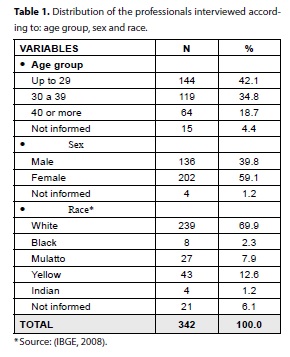
A total of 79% of the interviewees concluded their Dentistry graduation course in public federal universities (47.7%) and public state universities (47.7%). In relation to their academic formation, 58.5% had postgraduate courses, among which, the most frequent ones were: the Orthodontics (9.9%) and Endodontics (7.9%); whereas 39.5% stated to have only concluded their graduation course. Approximately half of the professionals (44.1%) had less than 8 years of graduation, 24.6% between 8 and 17 years and 14.9% had 18 years of graduation or more (Table 2).
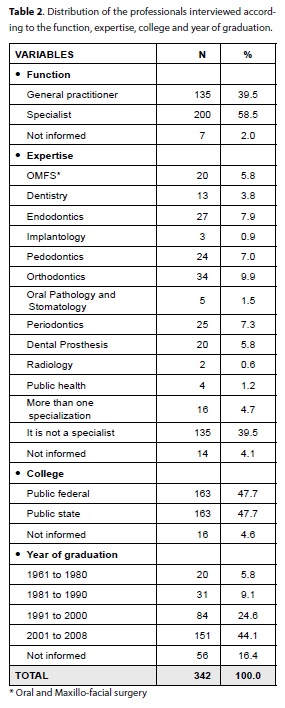
In relation to the facial aesthetics, the results demonstrated that 87.6% of the professionals interviewed did not know how to conceptualize the four essential components for the facial beauty: harmony, symmetry, equilibrium and normality (Table 3). It was verified that the concepts of harmony (68.6%) and normality (66.3%) got bigger percentages of accuracy as well as were considered, by an order of priority, the most important components to determine the facial beauty, with percentages of 63.7% and 30.7%, respectively. It is important to highlight that harmony, besides being the concept with the highest percentage of accuracy, got a higher difference of 10.3% in the female, presenting significant association (p < 0.05, OR equal to 1.60, but the interval to OR include the value 1.00). On the other hand, the male identified more the concepts of normality, equilibrium and facial symmetry (Tables 4 and 5).
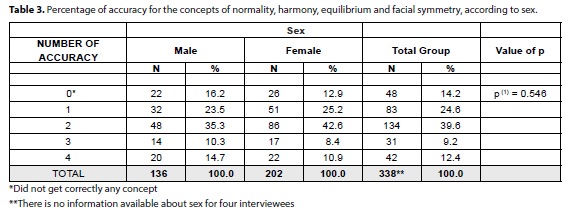
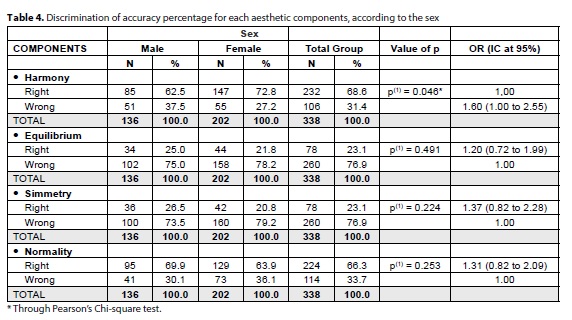

It was presented to the researchers seven criteria that can be used during the evaluation of the facial aesthetics of the patients and it was asked them to classify the criteria through an order of priority. It was verified that most of the professionals (47.7%) considered the taste (aesthetic preference) of the patient as the main criterion for the evaluation of the facial aesthetics, followed by the preference of the professional (25.7%) and the cephalometric analysis (20.8%) (Table 6).
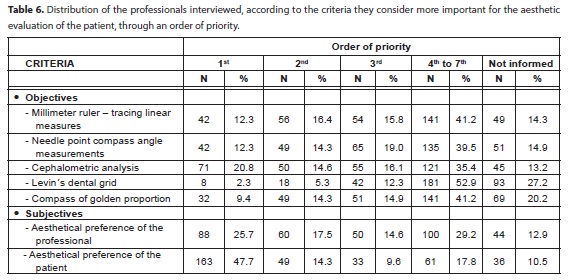
DISCUSSION
Nowadays, there are controversies about the concept of beauty used in Dentistry. For some authors, the concept of facial beauty is not considered scientific, as it depends on subjective impressions, since it varies according to people, ethnical groups, countries and times15. However, for other authors, beauty can be studied in a more scientific and objective way than in the past if certain criteria were used, for instance the "golden proportion", Levin's dental grid, cephalometric analysis, among others16,21,22.
The criteria used currently in aesthetical dentistry are inseparable from the evolution of the concepts of beauty. When the professionals use more objective parameters, the bequest goes back to Ancient Greece and Renaissance2. On the other hand, with the change of paradigm, during Modern Age, through the influences of Baumgarten and Kant, the appreciation of the beauty also depended on the subjectivity of the one who evaluates it6,9. However, it is interesting to observe that, despite the tendency that these two paradigms demonstrate in their associations, as for artists as for philosophers, there is a tendency among the health professionals who deal with the dentofacial aesthetics, as well as the lay people in general, to consider the beauty strongly determined by subjective factors14.
In our study, for the identification of the criteria used by oral surgeons for the evaluation of facial aesthetics, it was asked them, initially, to conceptualize the essential components for the facial beauty: normality, harmony, symmetry and equilibrium. It was verified that most of the professionals (87.6%) were not able to conceptualize correctly the four components. The most correct ones were harmony (68.8%) and normality (66.3%), while symmetry and equilibrium got both 23.1% of accuracy. We considered important the fact that when it was asked to the professionals to enumerate, through an order of priority, which of these concepts were considered more important for the analysis of the facial aesthetics, the chosen concepts were also harmony and normality with percentages of 63.7% and 30.7%, respectively.
Different interpretations can be considered while analyzing the percentages of accuracy and the choices, through an order of priority, of the main components that contribute to the identification of facial beauty. It deserves to be highlighted: a) the biggest ease that any individual has to identify the normality of the facial components; b) the fact that harmony is a more subjective concept and defined as something pleasant to be seen, it is intuitively and easily seized by the senses, since the man is potentially capable, independently of the scientific and social-cultural factors, to seize it21,23. In relation to the concepts of symmetry and equilibrium, despite having controversies in the literature to define them, since for some authors they are different concepts18,24; for Peck and Peck3, when applied to facial aesthetics, they refer to the similarity in size, shape and arrangement of the facial characteristics of both sides of the median sagittal plane. Evidently, the facial beauty can tolerate a detectable degree of asymmetry of the soft tissue, however, it is necessary to make distinction between the normal asymmetry, characterized by a small bulk decrease of one of the sides of the mid-sagittal line, and a pathological asymmetry17,24.
When it was presented to the interviewees criteria for the evaluation of the facial aesthetics of the patients, through an order of priority, they considered the aesthetic preference of the patient as the main criterion (47.7%), followed by the preference of the professional (25.7%) and the cephalometric analysis (20.8%). In this context, different studies have approached the importance of self-evaluation of the patient during the aesthetic treatment, since the concept of beauty can be influenced by several factors, it is possible to have as concepts of the beauty as individuals who want to express their opinions. (18) However, it is important to bear in mind that an aesthetic treatment can not only be determined by subjective and customized opinions of each patient nor subordinated to the individual aesthetic judgment of the oral surgeon, which, being strongly influenced by the esthetic sensibility, by emotional and sociocultural factors, as well as by his own academic formation, tends also to be more subjective2,16.
One aspect to be highlighted is that, in Dentistry, the preoccupation with the satisfaction of the patient has increased in the last four decades, as the people became more demanding with their own appearance, claimed more from the professional in relation to results of the aesthetic treatment. This fact encouraged the search for instruments that evaluate the degree of satisfaction of the patient, which contributed to improve the problem of communication between them19, besides forcing the professional to work more carefully, to consider the patient in his singularity, to attend him in a customized way, as the satisfaction of the patient is primordial to the success of the treatment25.
CONCLUSION
Such studies are interesting as the results can surprise. In our case, while delineating the academic profile of the professionals, we observed that, besides they are mainly specialists, therefore, with more than seven years of studies in Dentistry, the theoretical and clinical experiences acquired did not enable these professionals to realize a judicious analysis of the facial aesthetics of the patients, since they did not succeed in conceptualizing correctly the essential components for the facial beauty. Thus, during aesthetic treatments, they prefer to associate their own subjectivity and individual aesthetic preferences to the tastes of their patients, sharing responsibilities in the choices and avoiding dissatisfaction and litigation between them. However, the analysis of facial beauty should not be based essentially on subjective criteria, as this stance can interfere negatively in the planning and, consequently, in the final result of the treatment. Furthermore, in any odontological specialty that cares of facial aesthetics, different objective criteria can and should be used to help the professional in his aesthetic evaluation, since they were not used in an inflexible way, as if all faces could be adapted to them. If this imposition occurs, coarse and irreversible mistakes may not be avoided in the corrective and rehabilitative facial interventions. Finally, we highlight that efforts must be made to avoid overly complicated and inadequate planning or unnecessarily sophisticated, with the utilization of different objective-subjective criteria, often, exclusionary, that conceals narcissistic gains by professionals.
ACKNOWLEDGEMENTS
The authors would like to thank the Conselho Nacional de Desenvolvimento Científico e Tecnológico (CNPq) for the financial support of this study.
REFERENCES
1. Naini FT, Moss JP, Gill DS. The enigma of facial beauty: Esthetics, proportions, deformity, and controversy. Am J Orthod Dentofac Orthop 2006;130:277-82. [ Links ]
2. Peck H, Peck S. A concept of facial esthetics. Angle Orthod 1970;40:284-318.
3. Mack MR. Perspective of facial esthetics in dental treatment planning. J Prosth Dent 1996;75:169-76.
4. Murrell GA. Esthetics and the edentulous patient. J Am Dent Assoc 1988;117:57-63.
5. Ramirez OM, Novo Torres A, Volpe ChR. El ojo hermoso. Cir. Plást Iberolatinoam 2007; 33:79-90.
6. Nunes, B. Introdução à filosofia da arte. São Paulo (SP): USP; 1966.
7. Haughton N. Perceptions of beauty in Renaissance Art. J Cos Derm 2004;3:229-33.
8. Solnica S. L'harmonie dento-faciale selon les artistes de la Renaissance. Odonto-stomat 1974;1:27-37.
9. Huisman, D. Esquise d'une histoire de l'esthétique de Platon à nos jours. In: Boulay D. Les grans problèmes de l'esthétique. 2.ed. Paris, France: As F De Phi; 1961.
10. Kant I. Crítica da faculdade do juízo. 2.ed. Rio de Janeiro: Forense Universitária; 2005.
11. Khodoss, F. Kant: Le jugement esthétique. Textes choisis et treduits. 1.ed. France, Paris: PUF; 1966.
12. Agathos DJ. L´harmonie esthétique du visage. Orthop Dento- fac 1982;16:65-80.
13. Bashour, M. History and current concepts in the analysis of facial attractiveness. Plast Reconstr Surg 2006;118:741-56.
14. Duarte Júnior, JF. O que é beleza: experiência estética. 2.ed. São Paulo: Brasiliense; 1986.
15. Béry A. Esthétique et responsabilité. Chir Dent Fr 1985;55:55.
16. Edler R, Agarwal P, Wertheim D, Greenhill D. The use of anthropometric proportion indices in the measurement of facial attractiveness. Eur J Orthod 2006; 28:274–81.
17. Hulsey CM. An esthetic evaluation of lip-teeth relationships present in the smile. Am J Orthod 1970;57:132-44.
18. Rufenacht, CR. Fundamentals of esthetics. 1.ed. Chicago, Illinois: Quintessence Pub; 1998.
19. Bennet ME, Tulloch JF, Vig KW, Phillips CL. Measuring orthodontic treatment satisfaction: questionnaires development and preliminary validation. J Public Health Dent 2001;61:155-60.
20. Instituto Brasileiro de Geografia e Estatística: Indicadores sociais: síntese de indicadores sociais; 2008. [Acessed on 2011 Sep 01] Available at: http://ftp.ibgegov.br/Indicadores_ Sociais/Sintese_de_Indicadores_Sociais_2008/Tabelas/
21. Ricketts RM. The biologic significance of the divine proportion and Fibonacci series. Am J Orthod Dentofac Orthop 1982;81:351-70.
22. Baker BW, Woods MG. The role of the divine proportion in the esthetic improvement of patients undergoing combined orthodontic/orthognathic surgical treatment. Int J Adult Orthod Orthog Surg 2001;16:108-20.
23. Baudoin JY, Tiberghien G. Symmetry. Averageness and feature size in the facial attractiveness of women. Acta Psychol 2004;117:313–32.
24. Zaidel DW, Aarde SM, Baig K. Appearance of symmetry, beauty, and health in human faces. Brain and cogn 2005;57:261-3.
25. Albino JE, Tedesco LA, Conny DJ. Patient perceptions of dental-facial esthetics: Shared concerns in orthodontics prothodontics. J Prosth Dent 1984;52:9-13.
 Correspondência para:
Correspondência para:
Name: Silvana Orestes-Cardoso
Address: Rua Djalma Farias, 29 – Bairro Torreão
Recife – Pernambuco - Brasil
CEP: 52030-190
e-mail: silvanaorestes@hotmail.com
Recebido: 21/08/2014
Aceito: 05/08/2016













